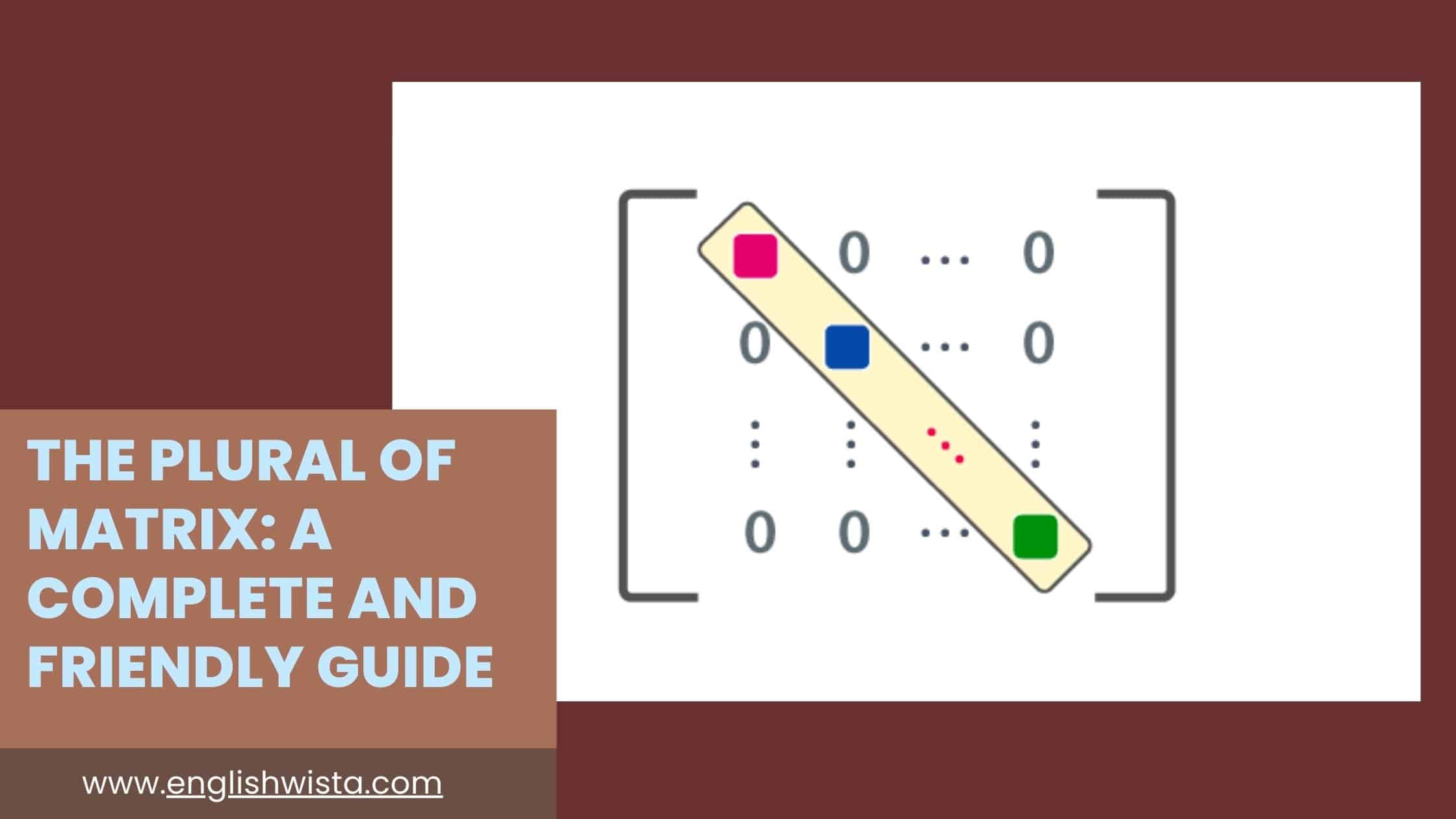Why Are We Talking About “Matrix”?
Have you ever come across the word matrix and paused, wondering how to make it plural? Maybe you saw it in a math textbook, a science article, or even when someone was talking about “The Matrix” movie series. At first glance, “matrix” looks simple, but when it comes to pluralizing it, things can feel a little tricky.
That’s because matrix is not an ordinary English word. It has roots in Latin, and words from Latin often follow special rules for forming plurals. Don’t worry by the end of this article, you’ll know exactly how to handle “matrix” in any context. We’ll explore its plural form, clear up common confusions, and see real-life examples that make everything crystal clear.
So, let’s take a closer look together.
What Is the Plural of Matrix?
The simple answer is:
- The plural of matrix is matrices.
Yes, you read that right. We don’t say “matrixes” (though it does appear in some informal contexts), but the standard and widely accepted plural is matrices.
Why? Because the word comes from Latin. In Latin, many words ending in “-ix” change to “-ices” in the plural. This same rule gives us other examples like:
- index → indices
- appendix → appendices
- vertex → vertices
So when you’re writing or speaking, remember: matrix → matrices.
Is “Matrixes” Ever Correct?
Now you might be wondering: can we ever say matrixes?
The short answer is yes but only in certain situations. While matrices is the preferred plural in mathematics, science, and formal writing, matrixes sometimes appears in everyday English or less technical contexts. For example, if someone is talking about movie “story matrices” or creative “idea matrices,” you may see matrixes instead.
So, both forms exist, but matrices is the safest choice, especially in academic or professional contexts.
Where Does the Word “Matrix” Come From?
It’s always fun to dig into word origins, and matrix has an interesting one. The word comes from Latin matrix, meaning “womb” or “source.” Over time, the meaning expanded to describe something that gives form, structure, or origin to other things.
That’s why we use “matrix” in so many fields today:
- In mathematics, a matrix is a rectangular arrangement of numbers.
- In biology, a matrix is the material in which cells are embedded.
- In geology, a matrix is the rock in which fossils are found.
- In general English, a matrix can mean a structure or environment in which something develops.
So, no matter the field, the plural matrices carries that sense of multiple structures, frameworks, or environments.
Examples of “Matrices” in Sentences
Seeing the word in action makes it easier to remember. Here are some clear examples:
- Mathematics:
“The professor asked us to add the two matrices together.” - Biology:
“Bone tissue contains collagen fibers within its matrices.” - Technology:
“The software can process several matrices of data at once.” - General English:
“Different cultural matrices influence how societies develop.”
Notice how matrices works across many areas, not just math.
Comparing Singular and Plural
Let’s lay it out side by side to make things super clear:
- Singular: matrix
- Plural: matrices (standard)
- Alternative plural: matrixes (less common)
Examples:
- “This matrix shows student scores.”
- “These matrices display all the data we collected.”
Why Isn’t It Just “Matrixes” Like Other Words?
This is a common question. English often bends rules because of its mixed heritage. Words with Latin or Greek origins tend to keep their original plural forms. That’s why we have:
- analysis → analyses
- criterion → criteria
- phenomenon → phenomena
Matrix follows the same pattern. Using matrices keeps the word consistent with its Latin root.
Everyday Usage vs. Technical Usage
It’s also useful to know that matrices and matrixes may appear in different contexts.
- In academic fields like math, science, and engineering → always matrices.
- In everyday writing or informal speech → you might see matrixes, though less common.
Think of it this way: if you’re writing a school paper, giving a presentation, or publishing something, go with matrices. If you’re chatting casually with friends, either works, though matrices still sounds more polished.
Fun Facts About the Word “Matrix”
Here are a few extras that make “matrix” even more interesting:
- The Movie Connection
The famous film The Matrix helped popularize the word in pop culture. However, in the movie’s title, “Matrix” is singular. If you were talking about multiple simulated worlds, you could jokingly say “multiple matrices.” - Mathematical Power
In linear algebra, matrices are one of the most powerful tools. They help solve systems of equations, transform graphics, and power computer algorithms. - Broader Meaning
The word “matrix” has become a metaphor. People use it to describe systems, structures, or environments. For example, you might hear: “We all live within social matrices that shape our choices.”
Practical Tips to Remember the Plural
Here are a few tricks you can use to never forget:
- Think Latin: If it ends in “-ix,” chances are the plural ends in “-ices.”
- Link with Index: Remember how “index” becomes “indices.” Just apply the same logic to “matrix.”
- Use in Sentences: Practice saying sentences like:
- “This matrix is complicated, but these matrices are even harder.”
- “The database organizes information into matrices.”
Repetition helps cement the correct form in your memory.
Common Mistakes to Avoid
Here are some errors learners often make:
- Writing matrixes in academic papers.
- Mixing singular and plural forms, such as “these matrix” instead of “these matrices.”
- Forgetting that matrices works across many fields, not just math.
The fix is simple: stick with matrices as the default plural, and you’ll be correct almost every time.
Quick Definition Recap
Before we wrap up, let’s define it in plain language:
- Matrix (singular): A structure, framework, or environment where something is formed or arranged.
- Matrices (plural): More than one structure, framework, or environment.
That’s all there is to it!
Conclusion: Takeaways on the Plural of Matrix
So, what have we learned today? Let’s recap in simple points:
- The word matrix comes from Latin, meaning “womb” or “source.”
- Its standard plural is matrices.
- An alternative plural, matrixes, exists but is less common.
- Matrices is the preferred choice in mathematics, science, and formal English.
- You can easily remember it by linking it to similar words like “indices” or practicing in sentences.
Next time you see “matrix” in a book, movie, or classroom, you’ll know exactly how to handle its plural. No more guessing, no more confusion just confidence.
So, the takeaway is simple: when in doubt, use matrices. It’s the form most people expect, and it will always sound natural and correct.



